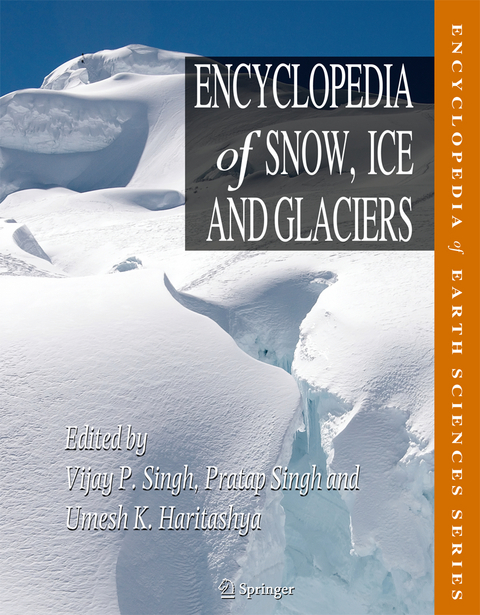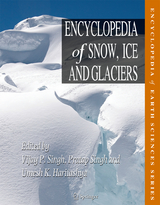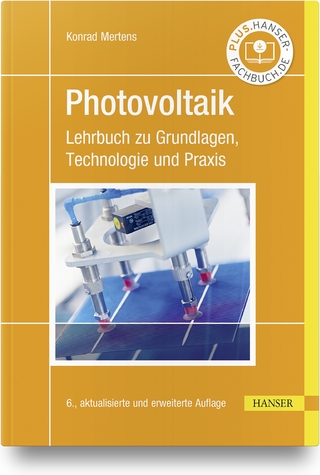Encyclopedia of Snow, Ice and Glaciers
The earth’s cryosphere, which includes snow, glaciers, ice caps, ice sheets, ice shelves, sea ice, river and lake ice, and permafrost, contains about 75% of the earth’s fresh water. It exists at almost all latitudes, from the tropics to the poles, and plays a vital role in controlling the global climate system. It also provides direct visible evidence of the effect of climate change, and, therefore, requires proper understanding of its complex dynamics.
This encyclopedia mainly focuses on the various aspects of snow, ice and glaciers, but also covers other cryospheric branches, and provides up-to-date information and basic concepts on relevant topics. It includes alphabetically arranged and professionally written, comprehensive and authoritative academic articles by well-known international experts in individual fields. The encyclopedia contains a broad spectrum of topics, ranging from the atmospheric processes responsible for snow formation; transformation of snow to ice and changes in their properties; classification of ice and glaciers and their worldwide distribution; glaciation and ice ages; glacier dynamics; glacier surface and subsurface characteristics; geomorphic processes and landscape formation; hydrology and sedimentary systems; permafrost degradation; hazards caused by cryospheric changes; and trends of glacier retreat on the global scale along with the impact of climate change.
This book can serve as a source of reference at the undergraduate and graduate level and help to better understand snow, ice and glaciers. It will also be an indispensable tool containing specialized literature for geologists, geographers, climatologists, hydrologists, and water resources engineers; as well as for those who are engaged in the practice of agricultural and civil engineering, earth sciences, environmental sciences and engineering, ecosystem management, and other relevant subjects.
Vijay P. Singh holds the Caroline and W. N. Lehrer Distinguished Chair in Water Engineering, and is also a Professor of Biological and Agricultural Engineering, and Civil and Environmental Engineering at Texas A & M University. He has authored 16 text and reference books, edited 49 books, authored 72 book chapters, and published more than 550 refereed journal articles, 320 conference proceedings papers and 70 technical reports. He is Editor‑in‑Chief of the Water Science and Technology Book Series of Springer, the ASCE Journal of Hydrologic Engineering, and Water Science and Engineering. He has received more than 60 national and international awards and numerous honors, including the ASCE’s Arid Lands Hydraulic Engineering Award; Distinguished Research Master Award from Louisiana State University; ASCE’s Ven Te Chow Award; AIH’s Ray K. Linsley Award; Hon. Ph.D. from University of Basilicata, Italy; Hon. D. Eng. from University of Waterloo, Canada; Hon. Member, American Water Resources Association; and Hon. Diplomate from American Academy of Water Resources Engineers. He is a fellow of ASCE, AWRA, IE, IAH, ISAE, and IWRS. He is a member/fellow of 10 international science and engineering academies. His research interests include surface and groundwater hydrology, hydraulic engineering, irrigation engineering, and mathematical and stochastic modeling. Pratap Singh has over 30 years experience in snow and glacier hydrology with an emphasis on modeling of snow and glacier melt runoff. He developed a snow melt model (SNOWMOD), which has been applied for streamflow simulation for snow- and glacier-fed rivers. He has published over 100 technical papers in international/national journals and co-authored with Professor V.P. Singh a book on Snow and Glacier Hydrology, published by Kluwer Academic Publishers, The Netherlands. He is Associate Editor for the Hydrological Sciences Journal, Wallingford, UK. Umesh K. Haritashya is afaculty member in the Department of Geology at the University of Dayton, where he teaches courses in glacial geology, geomorphology and remote sensing. He has extensive experience of working on many mountain regions around the world. His research interests include debris cover glacier characterization, glacier dynamics, contribution of glaciers to sea level rise, impact of climate change on mountain glaciers, and glacier hydrology. He is also associated with NASA’s GLIMS project and is an editorial board member of the Journal of Hydrologic Engineering, the Open Hydrology Journal, and Himalayan Geology.
Ablation Depression.-Ablatometer.-Acidity of Glacier Ice.-Active Ice Wedge.-Adfreeze.-Aerial Photogrammetry for Glacial Monitoring.-Alaskan Glaciers.-Albedo.-Alps.-Altai-Sayan Glaciers.-Anabatic Winds: In Relation with Snow/Glacier Basin.-Anchor Ice.-Andean Glaciers.-Anisotropic Ice Flow.-Antarctica.-Anti-Icing.-Anti-Syngenetic Ice Wedge.-Appalachian Glacier Complex in Maritime Canada.-Arctic Hydroclimatology.-Artificial Ground Freezing.-Artificial Production of Snow.-Atmosphere-Snow/Ice Interactions.-Atmospheric Circulation and Glaciochemical Records.-Automated Glacier Mapping.-Basal Sediment Evacuation by Subglacial Drainage Systems.-Base Flow/Groundwater Flow.-Bed (Bottom) Topography.-Bed Forms (Fluvial).-Bed Roughness.-Bed Strength.-Benchmark Glacier.-Biogeochemistry of Sea Ice.-Blue Ice.-Bottom Melting or Undermelt (Ice Shelf).-Brash Ice.-Calving Glaciers.-Canadian Rockies and Coast Mountains of Canada.-Cascade Mountains, USA.-Cascade System.-Catastrophic Flooding.-Catastrophic Rock Slope Failures and Mountain Glaciers.-Catchment Glacier.-Caucasus Mountains.-Characteristics of Snow and Glacier Fed Rivers in Mountainous Regions with Special Reference to Himalayan Basins.-Chemical Composition of Snow, Ice, and Glaciers.-Chemical and Microbe Records in Snow and Ice.-Chemical Processes in Snow and Ice.-Circulation and Mixing in Ice-Covered Lakes.-Cirque Glaciers.-Temperature and Precipitation.-Cloudburst.-Cohesion.-Cold-Based Glaciers.-Condensation Nuclei.-Confluence of Rivers.-Congelation Ice.-Crack.-Creep.-Crevasses.-Critical Temperature.-Crush.-Crust.-Cryoconite.-Cryodessication.-Cryofront.-Cryogenesis.-Cryogenic Aquiclude.-Cryogenic Fabric.-Cryolithology.-Cryopeg.-Cryosol.-Cryostatic Pressure.-Cryostructure.-Cryoturbation.-Dating Glacial Landforms.-Dead Ice.-Debris.-Debris Thermal Properties and Impact on Ice Ablation.-Debris-Covered Glaciers.-Deglaciation.-Degree-Days.-Depletion of Snow Cover.-Deposition from Debris-Rich Ice.-Digital Elevation Model Generation over Glacierized Region.-Digital Image Information Extraction Techniques for Snow Cover Mapping from Remote Sensing Data.-Direct Surface Runoff.-Discharge/Streamflow.-Distributary Channels.-Diurnal Cycle of Runoff.-Diverging Ice Flow.-Drift Glacier/Ice/Snow.-Dry and Wet Snow Line/Zone.-Dry Snow.-Dye Tracer Investigations of Glacier Hydrology.-Dynamics of Glaciers.-Elongation Ratio.-Englacial Conduit.-Englacial Processes.-.Environmental Isotopes.-Epigenetic Ice.-Epiglacial Morphology.-Equilibrium-Line Altitude (ELA).-Erosion of Hard Rock Bed.-Erosion Rate.-Estimation of Glacier Volume and Volume Change by Scaling Methods.-Estuary Ice Cover.-Fast Ice.-Finger Rafting.-Firn.-Fjords.-Foliation.-Forbes Band.-Formation and Deformation of Basal Ice.-Frazil.-Freezing Bottom (Ice Shelf).-Freezing Meltwater.-Freezing and Thawing Index.-Frequency Analysis of Snow Storms.-Fresh Water Storage.-Frictional Melting.-Frost.-Frozen Soil Hydrology.-Frozen Toe (Outer Zone of Glacier Snout).-Gelisols.-Geochemistry of Snow and Ice.-Geocryology.-GIS in Glaciology.-Glacial Drainage Characteristics.-Glacial Ecosystems.-Glacial Erosion.-Glacial Erratic.-Glacial Geomorphology and Landforms Evolution.-Glacial Grooves.-Glacial Overdeepening.-Glacial Striations.-Glacial Trough.-Glacial/Interglacial Cycles.-Glaciation During Times of Enhanced/Reduced Atmospheric Carbon Dioxide.-Glaciations and Groundwater Flow Systems.-Glacier.-Glacier Bird of the Andes.-Glacier Cave.-Glacier Field Studies: Important Things to Notice.-Glacier Hydrology.-Glacier Lake Outburst Floods.-Glacier Mass Balance.-Glacier Motion/Ice Velocity.-Glacier Pothole.-Glacier Sliding.-Glacier Surging.-Glacier System.-Glacier Toe.-Glaciers of the Karakoram Himalaya.-Glacieret.-Glacierization.-Glacioeustasy.-Glaciofluvial.-Glaciogenic Deposits.-Glaciohydraulic Supercooling.-Glacioisostasy.-Glaciolacustrine.-Glaciology.-Glaciomarine.-Glaciostatic Pressure/Stress.-Glaciotectonic Structures, Landforms, and Processes.-Global Climate Modeling in Cryospheric Assessment.-Global Outlook of Snowcover, Sea Ice, and Glaciers.-Global Warming and its Effect on Snow/Ice/Glaciers.-GPS in Glaciology, Applications.-GRACE in Glaciology.-Granulometry.-Gravel Sheet.-Gravitational Mass Movement Deposits.-Gravity Flow (Mass Flow).-Gray-White Ice.-Greenland Glaciers Outside the Ice Sheet.-Greenland Ice Sheet.-Ground Ice.-Ground Penetrating Radar Measurements over Glaciers.-Heat and Mass Transfer in Sea Ice.-High Elevation Glacio-Climatology.-Himalaya.-Himalayan Glaciers in 2010 and 2035.-Hindu Kush.-Holocene Glacier Fluctuations.-Horizontal Component of Ablation.-Horizontal Component of Velocity.-Hummocks (Peat).-Hydrochemical Characteristics of Snow, Ice, and Glaciers.-Hydrogen Isotopes.-Hydrographs.-Hydrologic Cycle and Snow.-Hydrological Response in Glacierized Basins.-Hydrology of Jökulhlaups.-Hydropower: Hydroelectric Power Generation from Alpine Glacier Melt.-Hypsometry.-Hysteresis.-Ice.-Ice Age.-Ice Age Cycles: Data, Models, and Uncertainties.-Ice Age Development Theory.-Ice Apron.-Ice Caps.-Ice Caves.-Ice Core.-Ice Covered Lakes.-Ice Dams.-Ice Sheet.-Ice Sheet Mass Balance.-Ice Shelf.-Ice-Cored Moraines.-Ice-Dammed Lakes.-Ice-Marginal Deposition.-Ice-Marginal Processes.-Ice-Volcano Interactions.-Icefall.-Iceland Glaciers.-ICESat Data in Glaciological Studies.-Icicle.-Icing.-Impacts of Snow and Glaciers on Runoff.-Interception of Snow.-Interflow.-International Polar Year 2007–2008.-Interstitial Ice.-Intrusive Ice.-Inventory of Glaciers.-Inverse Methods in Glaciology.-Inversion Layers.-Inverted Cup Depth Hoar Crystals.-Irreducible Water.-Isotope Analysis.-Isotopic Characteristics of Ice, Snow, and Glaciers.-Isotopic Fractionation of Freezing Water.-Isotopic Signatures.-Kame and Kettle Topography.-Katabatic Wind: In Relation with Snow and Glaciers.-Kilimanjaro.-Kunlun Mountains.-Lake Ellsworth.-Lake Ice.-Lake Vostok.-Laminated Sediments.-Landforms of Glacial Deposition.-Landformsof Glacial Erosion.-Landforms of Glacial Transportation.-Landscapes of Glacial Erosion.-Last Glacial Maximum Glaciation (LGM/LGP) in High Asia (Tibet and Surrounding Mountains).-Latent Heat of Condensation.-Latent Heat of Fusion/Freezing.-Latent Heat of Sublimation.-Latent Heat of Vaporization/Condensation.-Lateroglacial.-Lateroglacial Landform Systems.-Laurentide Ice Sheet.-Layering of Snow.-LIDAR in Glaciology.-Little Ice Age.-Lobe.-Mapping of Internal Glacial Layers.-Marginal Channel (Lateral Meltwater Channel).-Marginal Ice Zones.-Marine Glaciers.-Marine Ice Sheet.-Mechanical Weathering.-Median Elevation of Glaciers.-Mediterranean Glaciers and Glaciation.-Melt Runoff Modeling.-Melting Processes.-Meltwater Channels.-Meltwater Conduit.-Meltwater Erosion.-Meltwater Pressure.-Meltwater Storage.-Microorganisms Associated with Glaciers.-Monitoring and Warning Systems.-Monsoonal Records Observed from Snow/Ice/Glacier.-Moraine.-Moulins.-Mount Everest.-Mount Kenya.-Mountain Geomorphology.-Natural Hazards Associated with Glaciers and Permafrost.-Negative Temperature Gradient (in Ice).-Neoglaciation.-Network of Stakes.-New Zealand Glaciers.-Niche Glacier.-Normalized-Difference Snow Index (NDSI).-Nye (N) Channels.-Ogives.-Optical Remote Sensing of Alpine Glaciers.-Orographic Precipitation.-Outlet Glacier.-Overburden Pressure.-Oxygen Isotopes.-Palaeo Glaciofluvial Sediment Systems.-Palaeo-Channel.-Palaeo-Ice Stream.-Palaeoclimate and Past Glaciations.-Palaeohydrology.-Pamirs.-Pancake Ice.-Papua.-Paraglacial Landscape Transformations.-Patagonia.-Paternoster Lakes.-Peak Flood Glacier Discharge.-Percolation Zone.-Perennially Frozen Ground.-Periglacial.-Permacrete.-Permafrost.-Permafrost on Asteroids.-Permafrost and Climate Interactions.-Permafrost Modeling.-Permanent/Perpetual Snow Line.-Physical Properties of Snow.-Piedmont Glaciers.-Pingo.-Plastic Deformation.-Plastic Flow.-Pleistocene Epoch.-Plucking.-Polythermal Glaciers.-Precipitation.-Proglacial Lakes.-Quaternary Glaciation.-Radar Application in Snow, Ice, and Glaciers.-Radiative Transfer Modeling.-Radioactive Fallout.-Radioactive Isotopes.-Radioactivity.-Rain-Induced Snowmelt.-Ram Resistance.-Rating Curve.-Recession Coefficient.-Recession of Discharge.-Reconstruction of the Last Glaciations in the Whole of Asia.-Recrystallization of Ice.-Refreezing of Meltwater.-Regelation.-Remobilization (of Debris).-Resedimentation.-Retreat/Advance of Glaciers.-Rime Ice.-River Ice Hydrology.-Roche Moutonnees.-Rock Glaciers.-Rocky Mountains.-Röthlisberger (R)-Channels.-Runoff Coefficient.-Runoff Generation.-Runoff Observations.-Runout Distance.-Salinity.-Saltation.-Scandinavian Glaciers.-Sea Ice.-Sea-Level.-Seasonal Frost.-Seasonal Snow Cover.-Sediment Budgets.-Sediment Core and Glacial Environment Reconstruction.-Sediment Entrainment, Transport, and Deposition.-Sediment Flux Source-To-Sink.-Sediment Gravity Flow.-Sediment Routing.-Sediment Transfer Modeling.-Sediment Yield.-SEM Analysis of Glacial Sediments.-Septa of Englacial Debris.-Serac.-Siberia.-Slush and Sleet of Snow.-Snow.-Snow Bed/Snow Bed Vegetation.-Snow Course.-Snow Cover and Snowmelt in Forest Regions.-Snow Cover Changes in the Alps.-Snow Crystal Structure.-Snow Deformation.-Snow Density.-Snow Depth.-Snow Drift.-Snow Gauge.-Snow Grains.-Snow Hydrology.-Snow Layer.-Snow Load.-Snow Metamorphism.-Snow Microstructure.-Snow Pellet.-Snow Pillow.-Snow Pit.-Snow Ripening.-Snow Skating.-Snow Skiing.-Snow Storm.-Snow and Vegetation Interaction.-Snow Water Equivalent.-Snowboard.-Solifluction.-Solute in Glacial Meltwaters.-Solutes in Glacier Ice.-Specific Melt Rate.-Stable Isotopes.-Stage-Discharge Relationship.-Stationary Glacier.-Stratigraphy of Snowpacks.-Streamflow Trends in Mountainous Regions.-Structural Glaciology.-Subglacial Borehole Instrumentation.-Subglacial Drainage System.-Subglacial Lakes, Antarctic.-Subglacial Processes.-Subglacial Volcanism.-Subglacial Weathering.-Sublimation from Snow and Ice.-Summer Accumulation TypeGlaciers.-Super Cooling Clouds.-Supercooled Water.-Supra-Glacial Debris Entrainments.-Surface Energy Balance.-Surface Temperature of Snow and Ice.-Suspended Sediment Concentration.-Suspended Sediment Dynamics.-Suspended Sediment Load.-Synthetic Aperture Radar (SAR) Interferometry for Glacier Movement Studies.-Talik.-Tarn.-Temperate Glaciers.-Temperature Lapse Rates in Glacierized Basins.-Temperature Profile of Snowpack.-Terminus.-Terraces.-Thaw Weakening.-Thermal Infrared Sensors.-Thermal Regime of Ice-Covered Lakes.-Thermokarst.-Thinning of Arctic Sea Ice.-Thinning of Glaciers.-Tibetan Plateau.-Tidewater Glaciers.-Tien Shan Glaciers.-Till.-Topographic Normalization of Multispectral Satellite Imagery.-Transformations of Snow at the Earth’s Surface and its Climatic and Environmental Consequences.-Transient Snowline.-Tree-Ring Indicators of Glacier Fluctuations.-Tributary Glaciers.-Urban Snow.-U-Shape Valley.-Vein Ice.-V-Shaped Valley.-Water Balance in the Glacierized Region.-Westerlies and their Effects on Maritime Ice Caps and Glaciers.-WGMS (World Glacier Monitoring Service).-Winter Accumulation Glacier.-Year-Round Ablation Pattern.-Younger Dryas
| Reihe/Serie | Encyclopedia of Earth Sciences Series | Encyclopedia of Snow, Ice and Glaciers | 1.10 |
|---|---|
| Mitarbeit |
Anpassung von: Michael P. Bishop, Helgi Björnsson |
| Zusatzinfo | 428 Illustrations, color; 231 Illustrations, black and white; XLVI, 1253 p. 659 illus., 428 illus. in color. |
| Verlagsort | Dordrecht |
| Sprache | englisch |
| Maße | 210 x 279 mm |
| Themenwelt | Schulbuch / Wörterbuch ► Lexikon / Chroniken |
| Naturwissenschaften ► Biologie ► Ökologie / Naturschutz | |
| Naturwissenschaften ► Geowissenschaften ► Geografie / Kartografie | |
| Naturwissenschaften ► Geowissenschaften ► Geologie | |
| Naturwissenschaften ► Geowissenschaften ► Hydrologie / Ozeanografie | |
| Naturwissenschaften ► Geowissenschaften ► Meteorologie / Klimatologie | |
| Weitere Fachgebiete ► Land- / Forstwirtschaft / Fischerei | |
| Schlagworte | distribution of snow, ice and glaciers • glaciation, ice ages • Glacier dynamics • mass balance • snowfall and snow cover |
| ISBN-10 | 90-481-2641-X / 904812641X |
| ISBN-13 | 978-90-481-2641-5 / 9789048126415 |
| Zustand | Neuware |
| Haben Sie eine Frage zum Produkt? |
aus dem Bereich




